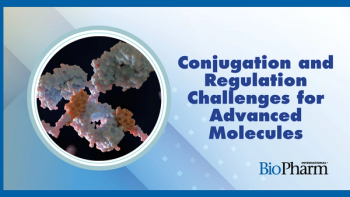
- BioPharm International July August 2025
- Volume 38
- Issue 6
- Pages: 8–11
Time-to-Market Pressures Are Influencing Downstream Processing Innovations
Increasing efficiency and quality through effective application of advanced technologies is becoming predominant.
Pressures to reduce manufacturing costs and improve productivity are driving development of innovative technologies and approaches for both upstream and downstream processing. Greater efficiency and scalability of purification operations must be achieved without impacting, and ideally improving, quality. For novel modalities, advances must also overcome increasing molecular and formulation complexity, and in many cases, highly flexible manufacturing solutions are needed that support production of very small quantities for precision medicine applications to large volumes for more prevalent diseases.
Continuous processing, PAT, and automation
With the need to address all these aspects simultaneously, implementation of automation, real-time monitoring using process analytical technology (PAT), and continuous/intensified downstream processing solutions is a key trend in the biopharmaceutical industry. Manufactures are also seeking to increase the flexibility, scalability, and customizability of downstream processing operations to accommodate the growing diversity of more complex biologic drug substances (e.g., bispecifics, antibody-drug conjugates, viral vectors) and product formulations (e.g., high-concentration, extended release). For many new modalities, there is also a push to develop downstream purification processes that afford higher-quality products.
“Process optimization that encompasses efficient resource utilization and quality improvement will continue to be trending as automation efforts expand across the biopharmaceutical industry,” says Joomyung Lee, director of downstream manufacturing with Samsung Biologics. “Additionally, integrated digital systems that enable real-time collection and analysis of process data are also emerging as essential infrastructure for ensuring quality in the industry.”
Adoption of multi-column chromatography and continuous processing platforms, particularly for high-titer and intensified upstream processes and integration of PAT, contribute to improved consistency, data integrity, and operational efficiency, according to Tyler Gadoury, senior director of process development at Catalent Biologics. He also observes that meeting the unique challenges posed by non-monoclonal antibody (mAb) modalities while aligning with evolving regulatory expectations requires more specialized purification approaches and advanced analytical methods driving innovation in both process design and analytical characterization.
Downstream processing of adeno-associated viral (AAV) vectors, for instance, presents unique challenges with respect to viral clearance, according to Brandon Carr, head of downstream process development, gene therapy research operations with Astellas. “Development of robust viral clearance strategies and continually progressing product quality are top priorities in downstream processing for these gene therapy products,” he states. In response to increasing quality and viral clearance and segregation expectations, Astellas is, for instance, implementing new unit operations and closed processing designs, while prioritizing real-time, PAT-based downstream process monitoring and control solutions.
Continuous processing and PAT also support better quality due to better process understanding and control, notes Yifeng Li, head of downstream process development at WuXi Biologics. Li also points to disposable chromatographic membranes and filters that reduce capital costs and contamination risk while increasing flexibility, making them ideal for multi-product facilities.
Advances in single-use technologies (SUTs) have led to wider availability of innovative solutions for various downstream processing steps and applications, adds James Pullen, senior director of downstream process development at FUJIFILM Biotechnologies, supporting the shift to more efficient and streamlined processing, including continuous operations.
Many drivers
Primary among the various factors driving innovation trends in downstream processing is the relentless push to reduce the time to the clinic and the market. “As companies race to bring therapies to patients faster, there is increasing pressure to shorten development timelines and streamline technology transfer,” comments Gadoury.
The need for speed is, in turn, leading to the desire to reduce costs and increase productivity, flexibility, and robustness, according to Li. With operational efficiency an important consideration, Gadoury adds that companies are seeking to reduce costs and improve productivity through expedited adoption of continuous processing strategies; tools that enable faster decision making and real-time, data-driven process control; automation; and generally improved visibility of the state of operations, both in development and manufacturing.
In addition to improving quality and lowering costs, Michael Brotz, director of manufacturing, science, and technology at AGC Biologics, highlights the new focus on domestic manufacturing, particularly in the United States and Europe, the increasing popularity of high-concentration formulations, and the higher titers produced upstream as important drivers of downstream processing technologies. He notes that the shift toward high-producing cell lines and high-concentration formulations is largely due to the move from intravenous to subcutaneous drug product presentations that support at-home administration for patient convenience and thus increased medication adherence.
Evolving client pipelines are also important, Pullen avers. As an example, he notes that the increasing presence of bispecifics, multispecifics, fragments, and fusion proteins, alongside standard mAbs, necessitates the use of specialized affinity chromatography resins that can effectively handle these varied biomolecules. Because these molecules more often exhibit unique challenges that cannot be addressed via traditional platform approaches, Gadoury also emphasizes the growing need for more sophisticated purification strategies and analytical capabilities.
Evolving regulatory expectations continue to impact downstream processing activities as well. Carr points to the International Council for Harmonisation (ICH) Q5A revision, which emphasizes a focus on robust viral clearance strategies for AAV and similar products (1). In European Union countries, compliance with REACH (Registration, Evaluation, Authorization, and Restriction of Chemicals) has also prompted the search for alternatives to Triton-based detergents, which have known environmental concerns. “We believe regulatory expectations will continue to evolve, placing a continued emphasis on both product quality and process control going into the future, benefiting both patients and the environment,” Carr affirms.
Lee adds that as digitalization of downstream processing activities increases, regulators are responding with increasing requirements regarding the traceability of real-time data and the accuracy and robustness of process data, which impacts the design and implementation of advanced processing solutions.
For contract development and manufacturing organizations (CDMOs) specifically, Lee also notes that continuous expansion of the CDMO sector is impacting facility and process design considerations. “The greater diversity of modalities and technologies is creating the need for more adaptable facilities that can standardize and automate complex development and manufacturing processes while ensuring consistent quality,” he explains.
Increasing role for advanced computing technologies
Advanced computing technologies can improve automation, real-time monitoring, and modeling capabilities that benefit downstream process development and performance, as well as play a critical role in enhancing downstream processing by enabling greater process understanding, control, and efficiency.
“A system that analyzes real-time trend data is one of the core technologies for improving downstream processing performance,” observes Lee. Gadoury adds that mechanistic modeling and digital twins allow for predictive simulations and optimization of unit operations, reducing development timelines and mitigating risk, while online process monitoring through PAT supports real-time control and ensures consistent product quality. Additionally, data visualization and analytical tools help identify trends faster, enabling more proactive decision-making.
“These technologies are particularly impactful in unit operations, such as chromatography and tangential flow filtration (TFF), where precise control and insight can improve process performance (or yield) and robustness,” Gadoury says.
While advanced computing technologies are essential across various unit operations, Charles Heise, associate director of global innovation for FUJIFILM Biotechnologies, agrees their application in chromatography is especially transformative due to the complexity and variability involved. “Through simulation, companies can optimize these processes to achieve greater efficiency and robustness in downstream processing,” he says.
For example, Lee notes that advanced computer systems can be used to conduct comparative analyses of real-time process data with historical data to identify subtle batch-to-batch changes/trends, helping operators promptly detect such issues as resin performance degradation and resin bed integrity, allowing corrective actions to be taken before problems arise.
Advanced modeling techniques are also highly beneficial for adsorption-based chromatography methods, according to Heise. “Numerous commercial and open-source software applications enable sophisticated mechanistic and hybrid models that enhance process understanding, mitigate risks during scale-up and technology transfer, and facilitate the creation of process digital twins,” he explains, adding that, “chromatography process digital twins can substantially reduce the need for conventional ‘wet’ experimental procedures, leading to faster process development and significant resource savings.”
PAT particularly noteworthy
PAT tools are being more heavily implemented in downstream processes to monitor titers and quality attributes in real-time, rather than relying on primarily offline analysis, according to Carr. The increased adoption of continuous processing in combination with the integration of real-time analytics through PAT, Gadoury believes, is in fact the most impactful innovation in downstream processing. “These innovations are improving consistency in product quality, reducing process durations, and enabling faster lot release,” he says.
Implementation of continuous processing/PAT solutions in downstream operations is nearly universal across modalities, but applications do differ based on the specific requirements of each molecule type, notes Brotz. For instance, PAT can be used to monitor excipients and protein for a conventional mAb during ultrafiltration/diafiltration and to monitor messenger RNA (mRNA)/DNA for mRNA therapeutics, while multicolumn chromatography can be applied to both gene therapy and antibodies.
AAV vectors can be challenging, however, Carr notes. “While many of these technologies have been positioned in the biologics space, nuisances of AAV purification complicate adoption for these products. Extensive development and engineering modifications are, thus, typically required to enable the effective use of select PAT tools in AAV manufacturing,” he comments.
Advanced chromatography solutions valued
As noted, some of the most impactful advances in downstream processing technology have been developed to improve the performance of the chromatographic purification step with respect to efficiency and quality.
An important area is the growing diversity of affinity chromatography chemistries, according to Alex Harley, subject matter expert in general process development with FUJIFILM Biotechnologies. “These developments improve purification for a diverse range of product types, enabling the reduction of complexity, creation of more simplified downstream processes, and enhanced efficiency, all of which contribute to processes that are more adaptable to evolving therapeutic needs,” he says.
Pullen adds that while Protein A remains the predominant choice for mAbs, demand is increasing for robust, high-capacity CH1 or Fab binders, as well as resins that can elute at higher pH levels to accommodate more sensitive mAb-related species.
An example noted by Gadoury are multi-specifics, which require custom affinity resins tailored to the Fc-region or asymmetric structures to achieve improved selectivity and yield during capture chromatography.
Multimodal chromatography as an analytical method has also become a vital resource for resolving complex product-related variants for next-generation antibody-based products (e.g., charge heterogeneity, chain mispairing), Gadoury comments. “For these complex molecules, success in downstream processing relies not only on optimized purification strategies, but also on the effective deployment of complementary and diverse analytical techniques.”
Another significant trend highlighted by Gadoury is the development and use of high-capacity resins with improved dynamic binding capacities and enhanced ligand stability. “These resins are critical for supporting higher-titer processes while also improving impurity clearance and reducing resin costs,” he contends.
One of the most impactful innovations for Li has been membrane chromatography due to its high productivity, low cost, low pressure drop, small facility footprint, and good scalability and disposability compared with traditional column chromatography.
In the AAV space, Carr notes that ion exchange chromatography shows limited suitability as a sole means of enrichment for certain engineered capsids, leading to the search for other more effective separation approaches. Enabling this and other investigative efforts, he observes, are advanced techniques for rapidly profiling products and impurities and thus gaining greater understanding of both processes and therapeutics.
For products in the advanced therapy medicinal product (ATMP) space that involve such large biomolecules as viral vectors, radial flow chromatography stands out as a significant advancement for Harley. “Unlike conventional axial flow approaches that can lead to fouling in chromatography beds due to large molecules, radial flow chromatography provides bed supports better suited for larger product sizes,” he says. “This technique improves purification efficiency and reduces downtime, which is vital for maintaining productivity in ATMP manufacturing.”
“These many chromatographic innovations are,” concludes Harley, “significant because they address specific challenges related to diverse product pipelines and large biomolecule processing, contributing to more streamlined, flexible, and efficient downstream processing operations across all modalities.”
Precision medicine and next-gen therapy manufacturing
Traditionally, downstream processing has focused on scaling up and maximizing process efficiency to reduce costs. Precision medicines and advanced therapies, however, typically have lower volume demands, shifting the focus to performing small-scale operations in a good manufacturing practice environment.
The result has been the development of small-scale, single-use equipment that allows for efficient processing at reduced volumes, according to Heise. That includes, for instance, scaling down and fully closing processes that have traditionally been only functionally closed, including chromatography and TFF. In addition, he observes that novel chromatography chemistries and new methodologies have been developed, and niche techniques like radial flow chromatography have been applied to support tailored purification of these specialized products.
Efforts are also focused on reducing the costs of goods (COGs) of downstream operations. “COGs will continue to be a very important consideration for next-generation therapy manufacturing,” Carr states. Astellas has, therefore, been heavily focused on COGs reduction through improvements in upstream productivity, downstream engineering optimizations, and yields.
It is worth noting that the benefits of these advanced technologies have not been limited to novel modalities. The adapted equipment can enable downstream processing of higher concentration formulations, scale down of clinical programs, and closed processing for high potency drug substances/drug products, notes Brotz.
“While these advances have been catered to next-gen therapies, they are also influencing downstream processing for conventional products, potentially enhancing efficiency and adaptability across the board,” Heise adds.
Considering upstream impacts
Downstream purification operations are not performed in isolation, and in fact the specific performance needs of downstream processes are dictated to a great extent by upstream activities. “The yield and purity that can be achieved in downstream processing heavily rely on the molecular design, cell-line development, and cell-culture process development, especially for complex molecules such as bispecific antibodies,” says Li.
As such, potential downstream process-related challenges should be taken into consideration during the developability assessment stage of a project so the downstream processing team can provide feedback and have advanced understanding of the molecule before formal downstream process development begins. This approach, Li notes, minimizes potential challenges and risks that can delay or derail projects at later development stages.
Carr, in fact, highlights the need for more product understanding for such modalities as AAV, particularly regarding the impact of upstream unit operations on product heterogeneity and other select quality attributes.
Pullen, meanwhile, emphasizes the value of developing continuous downstream processes for drug substances manufactured using upstream perfusion processes. “Seamless integration of continuous upstream and downstream processes enables end-to-end closed processing in a significantly reduced facility footprint, providing both efficiency and quality gains that contribute to cost savings and process optimization,” he explains.
Evolving challenges will continue to drive innovation
The current trends driving innovation in downstream processing are expected to continue impacting biologics drug manufacturing for the foreseeable future. As such, industry experts expect to see a continued focus on increasing efficiency, scalability (up and down), and flexibility to enable more effective purification of the wide diversity of molecules in the biopharmaceutical pipeline. The shift toward continuous manufacturing leveraging advanced PAT tools will remain a prominent trend.
Where possible, manufacturers will seek to develop platform processes, but for some novel modalities, many aspects of downstream processing will continue to present unique challenges that will require evolving, customized solutions. Further advances are thus expected in SUTs that enable fully closed processing and facilitate effective downstream processing of many modalities over a wide range of manufacturing scales in multiproduct facilities. Examples include more robust flow paths, improved disposable or non-contact sensors, and solutions for processing steps for which effective SUTs have yet to be developed.
The move to continuous manufacturing will concomitantly drive additional innovations in automation and real-time data analytics, enhancing consistency and efficiency while further streamlining and de-risking downstream processes.
In the longer term, innovative separation technologies may emerge that have the potential to improve downstream processing efficiency and costs. Sustainable process development will become a prerequisite for environmental, social, and governance compliance, Lee notes.
Artificial intelligence and machine learning are also anticipated to dramatically improve downstream processing design and control. Impacts will not be measurable, however, until sufficiently large, high-quality datasets have been established. Many hope for implementation of fully continuous, digital, downstream processing platforms that provide high-quality products in much less time at a much lower cost.
Overall, concludes Harley, downstream processing will continue to evolve toward greater efficiency, flexibility, and precision, improving capabilities for both conventional and next-generation therapies with the goal of reducing time and cost and increasing patient access.
Reference
- ICH. Q5A(R2) Viral Safety Evaluation of Biotechnology Products Derived from Cell Lines of Human or Animal Origin (ICH, Nov. 1, 2023).
About the author
Cynthia A. Challener, PhD, is a contributing editor to BioPharm International®.
Article details
BioPharm International®
Vol. 38, No. 6
July/August 2025
Pages: 8–11
Citation
When referring to this article, please cite it as Challener, C. Time-to-Market Pressures Are Influencing Downstream Processing Innovations. BioPharm International 2025 38 (6).
Articles in this issue
Newsletter
Stay at the forefront of biopharmaceutical innovation—subscribe to BioPharm International for expert insights on drug development, manufacturing, compliance, and more.




